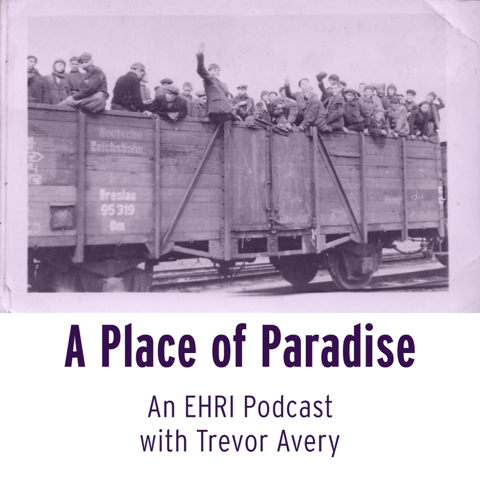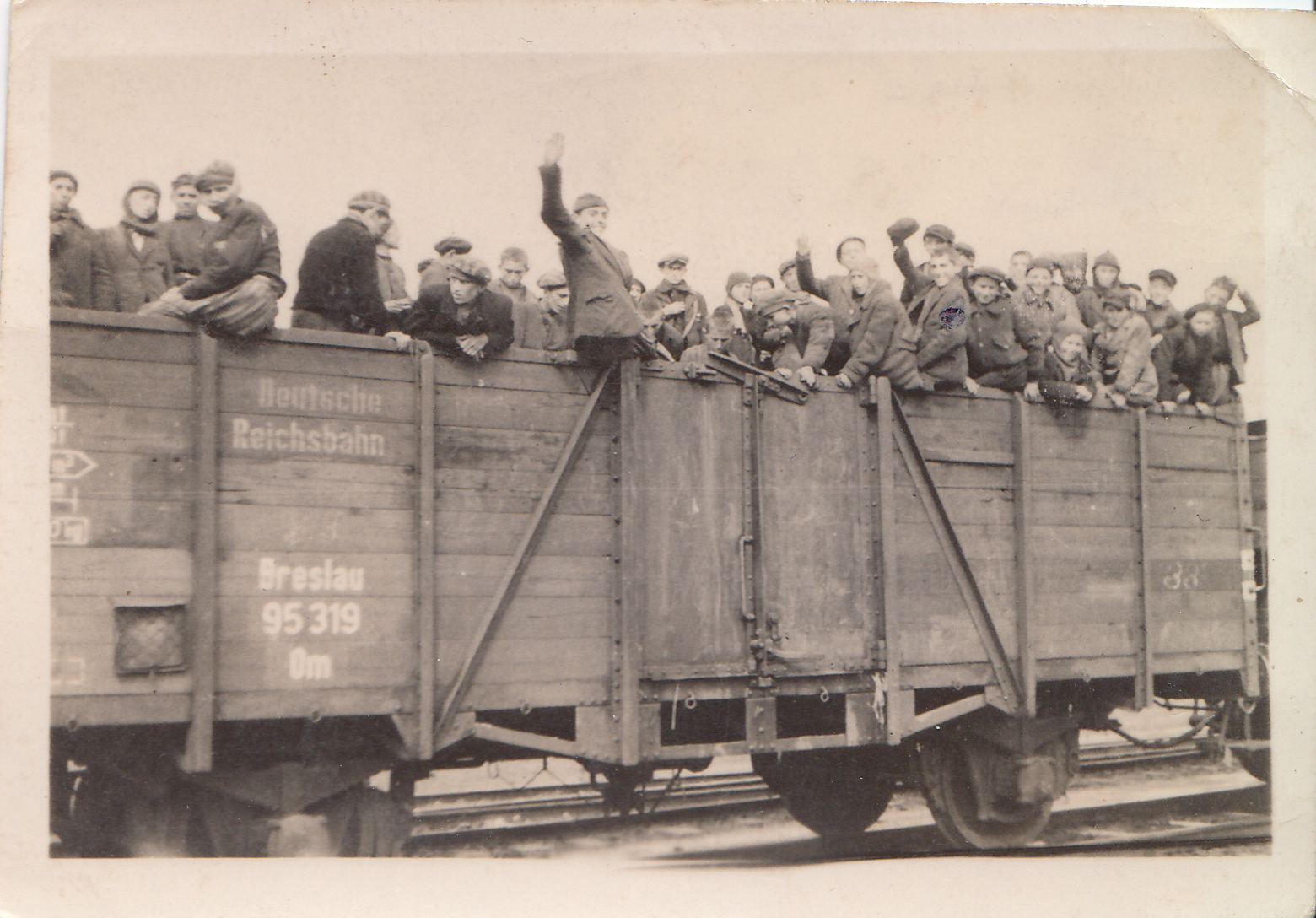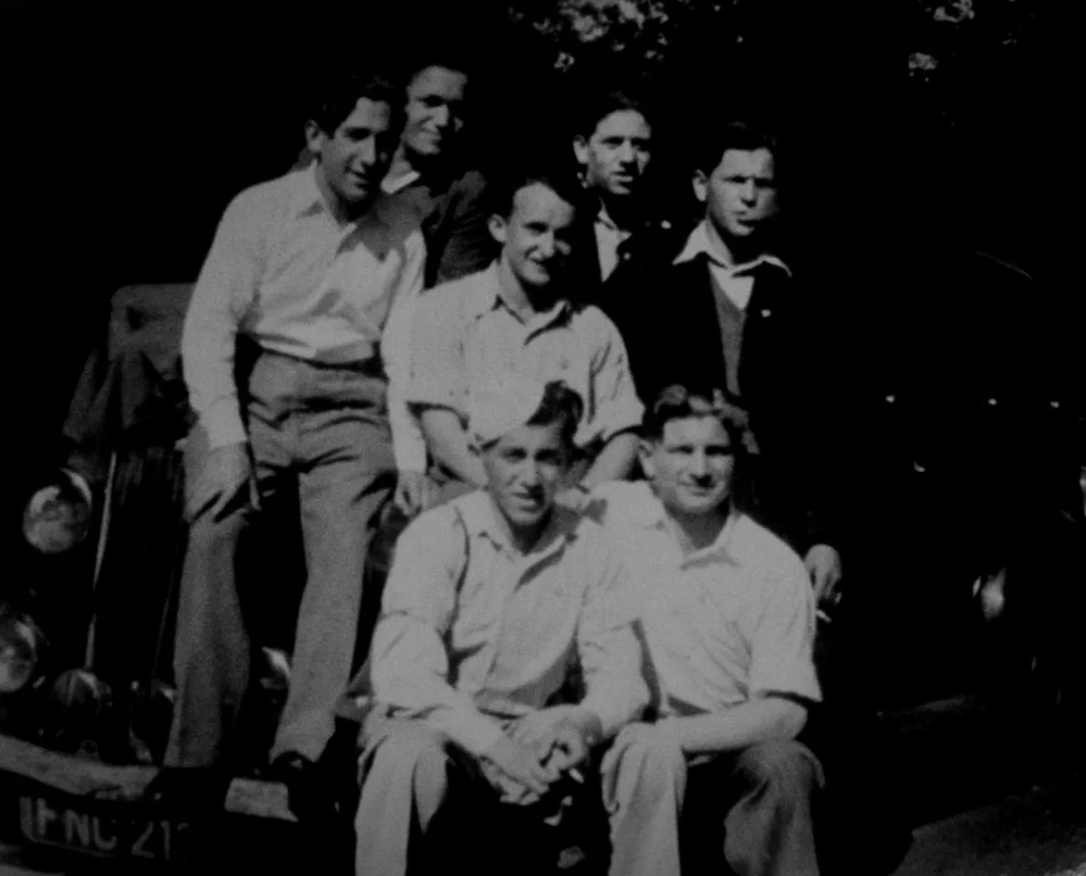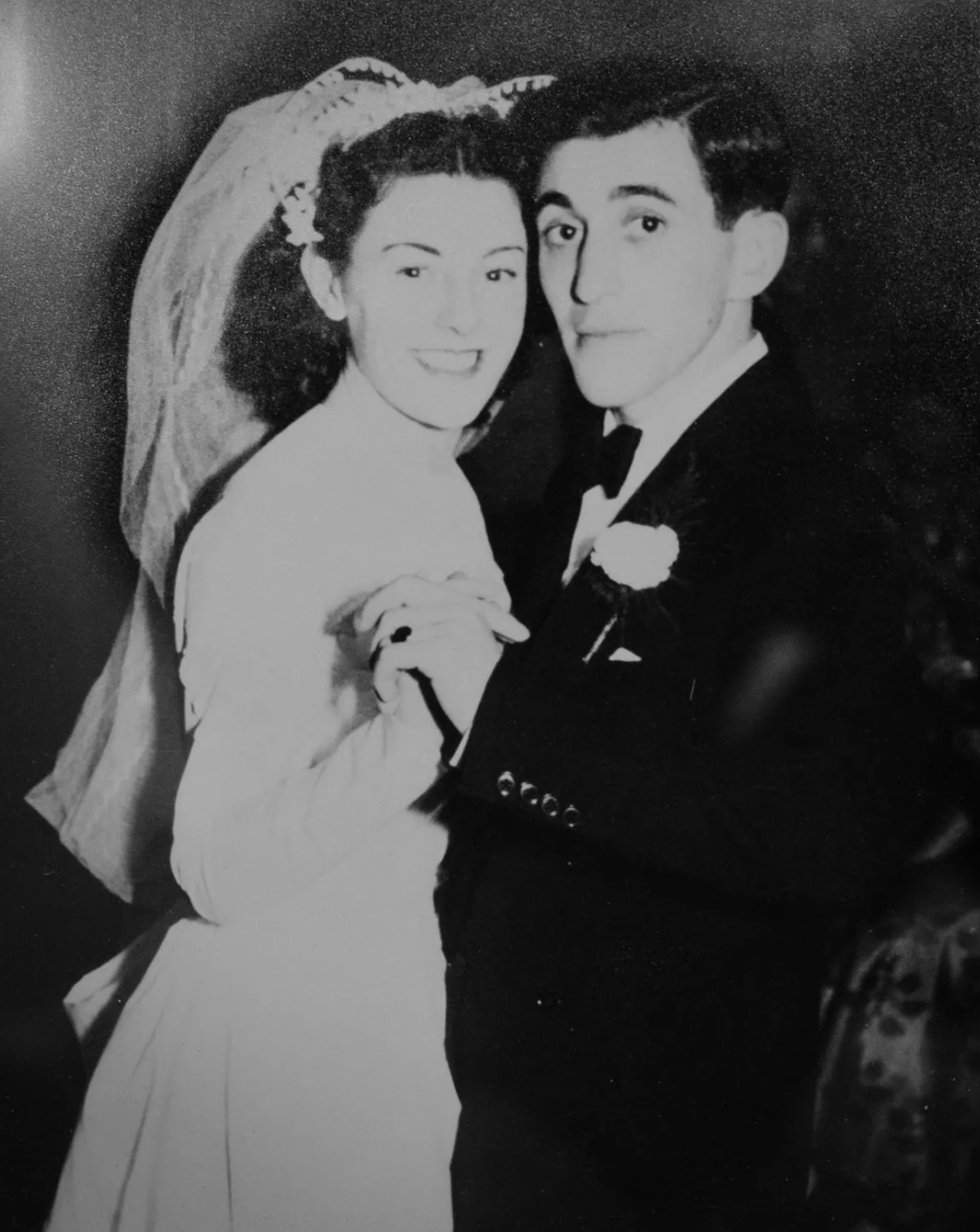Podcast Episode | A Place of Paradise

Release date: 31-10-2024 | More about the Podcast Series For the Living and the Dead. Traces of the Holocaust
A Place of Paradise
In this episode, the object of our focus is a black and white photograph that offers a harrowing glimpse into the narrow survival of Nazi camp prisoners. Two of the survivors in this image would later travel to the ‘paradise’ of Windermere, in the Lake District in England, on 14 August 1945. The image contains a stark contrast; the jubilant gestures of greeting from the gaggle of young survivors sits in juxtaposition with the cargo train they are loaded onto, a vehicle normally used for transporting goods and chattel and speaks to the extraordinary nature of the story behind it.
The photo is remarkable, not least because it captured the precise moment of liberation on May 8th, 1945, for many of the young survivors – who were meant to be taken to Theresienstadt camp ghetto – but because the train contains two young Jewish survivors who later became known as part of “The Windermere Group”. The podcast focuses on Ike Alterman, one of the 300 young Jewish orphans who were selected to travel to Windermere for recuperation. Ike survived no less than four concentration camps and multiple death marches by the time he was sixteen, and it is because of him that this photograph, along with many others, has found its way into the safekeeping of The Lake District Holocaust Project. We hear from Ike’s testimony in this episode, and how this photograph was taken only minutes after the survivors found out that they had been freed.

on May 8th 1945 in Theresienstadt
Ike Alterman was born in 1928 in Ożarów, Poland to a large, Orthodox Jewish family. His upbringing was happy, but his life and that of his family was changed in the short matter of weeks after the Nazi invasion of Poland in 1939. Ożarów was taken over by the Nazis and made into its own Ghetto which meant that whilst his family were not forcibly removed, the conditions of their lives changed drastically and for two years they lived in fear, poverty and persecution. After two years, the horrible moment came in which Ike’s family were separated; his mother, brother and sisters were sent to Treblinka, never to be heard of again. Ike and his father were taken to Blyzin as slave labourers, but were later separated too. Aged only thirteen or fourteen, Ike was alone in a horrific system of violence.
Ike was transported from Blyzin to Auschwitz-Birkenau and then from there to Buchenwald by way of a death march, finally arriving in Theresienstadt in 1945. Through Ike’s powerful testimony, we hear the atrocities of life in these camps. What makes his testimony unique, as is discussed in this episode, is that Ike’s work at Auschwitz-Birkenau put him in the unusual position of entering the crematoriums used as part of the Nazi’s ‘final solution’ to collect clothes, making Ike one of the last living survivors who actually witnessed such crematoriums in operation and the atrocities they concealed.
In this episode, we are joined by historian Trevor Avery, who initiated The Lake District Holocaust Project in 2013 that holds various exhibitions about the Holocaust survivors who came to Windermere in 1945. Avery was also the primary researcher for the British TV film “The Windermere Children”.
Trevor will tell us more about this remarkable photograph and extraordinary story of Ike Alterman. Listen to the episode on Buzzsprout, Spotify, Apple Podcasts or here:
The Windermere Project
There are two children pictured in Ike Alterman’s photograph that ended up in Windermere although a number of other children were in the same truck, and others on the same train, who also went to Windermere. The scheme was in part thanks to the support of the British Central Fund and was the brainchild of philanthropist Leonard Montefiore. There was of course, at the heart of the idea, the wish to offer these children the chance of a new life after having lost everything, but Montefiore also thought it would be a good idea to have survivors living among British people to remind them of the reason for the sacrifices many made during the Second World War. While Montefiore had this idea in May 1945, the Red Cross and the Quaker Society, who were inundated with survivors in desperate need of help, put out a call to the nations of Europe, requesting help with taking in the young and needy, and the project began to take shape.

Image: ABNM Photography
The British Government and the Central British Fund agreed to take 1,000 young people into Britain, and Edith Lauer, who at that time oversaw the children’s section of Theresienstadt, was instructed to select 300 children to be taken to Windermere. The requirements for travel set out by the British Government were clear; the children needed to be between the ages of eight and 15 and be in triple A fitness. In reality, the youngest amongst the children was only two years old and many of those who arrived in the UK were instantly committed to hospital. This was because of the incredible humanity shown to the children by an unknown medical officer who was responsible for selecting the children. Although the medical officer is mentioned in multiple testimonies, they were sadly never identified.
The idea of the project was to help the children rehabilitate and recover; there were teachers and therapists made available to them and upon their arrival in the breathtaking setting of Lake Windermere, their slow journey to recovery began. Key to the process was for the children to be made to feel safe again, and through respect, dignity and kindness shown to them by the local community, they were able to survive the stages of grief that came through their being there and learning that they would not be reunited with their families again.
Ike’s Life After Windermere
After 1946, when the Windermere project officially ended, Ike moved to Manchester where he was provided with accommodation, carers and job opportunities. Ike worked diligently, describing the ache of the pain of his loss as a driving force behind his determination to secure himself a future; by the age of twenty-two he had his own factory. He went on to build one of the most successful jewelry businesses in the city. He married Myra and had two daughters, Elaine and Fione. Myra sadly passed away in 1991.

Ike is an active Holocaust educator even at the age of 95 and now has a wonderful partner and companion in Diane who has supported him while he has dedicated much of his life to sharing his experiences. To this day, he talks to media and journalists and gives talks at schools to educate future generations about the atrocities of the Holocaust.
The Lake District Holocaust Project
What started as a two-year research project by historian, Trevor Avery, The Lake District Holocaust Project has continued to span nearly two decades. Avery explains in this episode how he set about to uncover, preserve and share the incredible stories of bravery, trauma and kindness that characterize the experiences of the children who were selected to come to Windermere in 1945. Avery found that there was a wealth of important archival material belonging not only to the children themselves but held by the local community who were irrevocably marked by the year the children spent there.
The permanent exhibition ‘From Auschwitz to Ambleside‘ is on display on the first floor of Windermere Library and is free and accessible to anyone interested in learning more about the stories of these children and how a community came together to help them recover and grieve. The project keeps growing as Avery continues to uncover new stories buried within the layers of the material they have assembled; he and his team want to ensure that everything is safely and securely documented for future generations. With only a handful of survivors still living, he is glad that the exhibition contains much crucial oral testimony that is paired with archival materials such as documents, letters and photographs. Trevor Avery is a director of The Lake District Holocaust Project.
Poland in WW2 on the EHRI Portal
On the eve of the Second World War, the Polish Republic had an estimated total population of 35 million inhabitants. Some 3,500,000 of them were Jews. Within weeks of the invasion, about two million Polish Jews came under German occupation. Individual murders by German soldiers were not uncommon during the early days of the war and discrimination against the Jewish population in general began immediately. Jewish property was confiscated, synagogues were demolished or devastated. Jews were forced to wear badges or armbands identifying them as Jews and were gradually confined in ghettos throughout the country.
By early 1941, almost half a million people had been packed into the Warsaw ghetto alone where many would die as a result of the terrible living conditions there. In western Poland, which had been annexed immediately to the German Reich, and the western part of the Warsaw region, the Jewish population was expelled further east or transferred into larger ghettos (principally Warsaw and Łódź). In June 1941, the mass extermination of Jews began in Eastern Poland. From December 1941, Jews were systematically murdered in the parts of Poland which had been under German occupation since 1939. The first extermination centre was established in Chełmno (Kulmhof), north of Łódź. Its victims were not only Polish Jews from the regions annexed to the Reich, but also German, Austrian and Czech Jews who had previously been deported to the Łódź ghetto. Within the framework of Operation Reinhardt, the German authorities established extermination centres (Bełżec, Sobibór and Treblinka) aimed at the extermination of the whole Jewish population of the General Government. The Warsaw Ghetto Uprising in spring 1943 was crushed by the Germans and the ghetto itself destroyed. Some Jews were sent to the Lublin-Majdanek and Auschwitz concentration camps, where the majority were murdered. Jews from other European countries were also deported to these camps to be killed.
While Operation Reinhardt ended in 1943, mass murder did not. The gas chambers in the concentration camp Auschwitz-Birkenau operated until 1944. The inhabitants of ghettos which had so far been spared found their end here: Jews from the Białystok and the Zagłębie regions were killed in 1943, those from Łódź in 1944. At the same time, Jews were brought to Auschwitz from various countries occupied or dominated by Germany, for example Czechoslovakia, France, Greece, Hungary and the Netherlands. They were submitted to selection: the able-bodied were sent to the concentration camps, the others (including the children) were murdered on the spot.
The last Jewish victims of Nazi mass murder in Poland were the concentration camp inmates, who died from exhaustion or were shot during the evacuation of the camps (during the so-called Death Marches, for instance from Auschwitz and Stutthof). Soviet Army troops were the first to approach a major Nazi camp in Poland at Majdanek in July 1944 and to overrun the previously dismantled death camp sites of Bełżec, Sobibór and Treblinka. In January 1945, they liberated Auschwitz. About 3 million Jews from within the pre-war borders of Poland did not survive the war (two thirds of whom died in the territory of present-day Poland). Approximately 13% of the Polish Jewish pre-war population survived the war, mostly as refugees or deportees in the unoccupied parts of the Soviet Union.
Learn More
-
Rock the Cradle by Marie Paneth
-
Read about Ike’s life in the My Voice book collection, a stand-alone project of The Fed, the “leading Jewish social care charity in Manchester, dedicated to preserving the life stories of Holocaust survivors and refugees from Nazi persecution who settled in the UK”
-
Learn more about the life stories of Holocaust survivors and refugees from Nazi persecution in the UK: The Fed’s My Voice Project in Manchester
-
Listen to a podcast by The Fed Project that includes Ike’s testimony
Credits
Our thanks go to:
-
Trevor Avery, Director of the Lake District Holocaust Project
-
Ike Alterman for agreeing to talk about his life experience
-
The production team of The Windermere Children: in their own words for giving permission to use fragments of the audio testimonies
-
Our first EHRI intern Anthonia Prins for helping develop this remarkable story into a script
-
Music accreditation: Blue Dot Sessions. Tracks – Opening and closing: Stillness. Incidental, Gathering Stasis, Pencil Marks, Uncertain Ground, Marble Transit and Snowmelt. License Creative Commons Atttribution-NonCommercial 4.0 International (BB BY-NC 4.0).
-
Andy Clark, Podcastmaker, Studio Lijn 14
